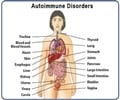There is strong evidence that cross-reactivity between human and microbial proteins drives autoimmune diseases.
- Some T cells that respond to microorganisms may also respond to normal human proteins, resulting in autoimmune illness
- The findings indicate that efforts to enhance diagnostic tools and therapies for autoimmune illnesses can be accelerated
HLA Gene Variants Linked to Autoimmune Diseases
“Of all genes, the Human Leukocyte Antigen (HLA) genes have the greatest amount of variation across the human population. Many, many autoimmune diseases are associated with specific variants of the HLA genes, and in most cases, we don’t know why,” said co-corresponding author Wayne M. Yokoyama, M.D., the Sam J. Levin, and Audrey Loew Levin, Professor of Arthritis Research at Washington University. “This paper outlines a strategy for figuring out why certain HLA variants are linked to certain diseases. It also provides strong evidence that cross-reactivity between human and microbial proteins drives autoimmunity in at least two diseases and probably many others. Now that we understand the underlying drivers, we can start focusing on the approaches that are most likely to yield benefits for patients.”Ankylosing spondylitis, which causes arthritis in the spine and pelvis, and acute anterior uveitis, which causes inflammation in the eye, are both highly linked to an HLA variant known as HLA-B*27. Ankylosing spondylitis and HLA-B*27 were discovered 50 years ago, making it one of the earliest such relationships established between disease and HLA variants, and it remains one of the strongest known associations between any disease and an HLA variant.
What are HLA Gene Variants
The HLA protein family, which is extremely variable between individuals, aids immune cells in detecting invading infections and discriminating between microbial and human proteins. HLA proteins act like hands, picking up fragments of whatever proteins are lying around- microbial or human- and presenting them to immune cells called T cells to determine whether they are an indication of danger (microbial) or not (human).T cells don’t just recognize protein fragments; they recognize the fragment as well as the hand that carries it. Scientists have long suspected that the combination of this specific hand- HLA-B*27- with a small amount of an unknown human protein was being mistaken as hazardous in persons with either of the two disorders, causing autoimmune responses in the eye or the spine. But they couldn't discover the fragment for decades. Some scientists speculated that the misidentification hypothesis was incorrect and that the link between HLA-B*27 and the two diseases was due to something else.
Yokoyama and co-first author Michael Paley, M.D., Ph.D., of Washington University, collaborated with co-corresponding author K. Christopher Garcia, PhD, and co-first author Xinbo Yang, Ph.D., of Stanford Medicine, as well as co-corresponding authors Geraldine M. Gillespie, Ph.D., and Andrew J. McMichael, Ph.D., and co-first author Lee Garner, Ph.D., of Oxford University. The researchers discovered that certain T cells were plentiful in the blood and joints of persons with ankylosing spondylitis, as well as in the eyes of people with uveitis.
Garcia and Yang then established a method for identifying protein fragments that, when paired with HLA-B*27, induce a T cell response, then mapped the fragments against the human genome and five bacterial genomes to discover proteins from which the fragments may have originated. They were able to narrow down the millions of options to a limited list of human and microbial proteins using this method. The researchers next analyzed the architecture of the detector molecules, known as T cell receptors, on T cells from both groups of patients. The parallels were startling.
Molecular Pathways in Autoimmune Diseases
“This study reveals the power of studying T cell specificity and activity from the ground up; that is, identifying the T cells that are most active in a given response, followed by identifying what they respond to,” Garcia said. “These patient derived TCRs are seeing a spectrum of common antigens, and that may be driving the autoimmunity. Proving this in humans is very difficult, but that is our future direction and could lead to therapeutics.”The findings shed light on important parts of the molecular pathways that underpin ankylosing spondylitis, anterior uveitis, and maybe many other autoimmune disorders.
“By combining recently developed technologies, we have revisited an old hypothesis that asks if the traditional antigen-presenting function of HLA-B*27 contributes to disease initiation or pathogenesis in the autoimmune conditions ankylosing spondylitis and uveitis,” Gillespie said. “Our findings that T cells at the sites of pathology recognize HLA-B*27 bound to both self and microbial antigens add a very important layer of understanding to these complex conditions that also feature strong inflammatory signatures. We hope that this work will one day pave the way for more targeted therapies, not only for these conditions but ultimately, for other autoimmune diseases.”
The findings promise to expedite efforts to enhance diagnostic tools and treatments for autoimmune illnesses by giving strong support for the hypothesis that T cells that react to pathogens may also react to normal human proteins.
“For ankylosing spondylitis, the average time between initial symptoms and actual diagnosis is seven to eight years,” said Paley, an assistant professor of medicine, ophthalmology, and pathology & immunology. “Shortening that time with improved diagnostics could make a dramatic impact on patients’ lives because treatment could be initiated earlier. As for therapeutics, if we could target these disease-causing T cells for elimination, we could potentially cure a patient or maybe even prevent the disease in people with the high-risk genetic variant. There’s a lot of potential for clinical benefit here.”
Source-Medindia
















